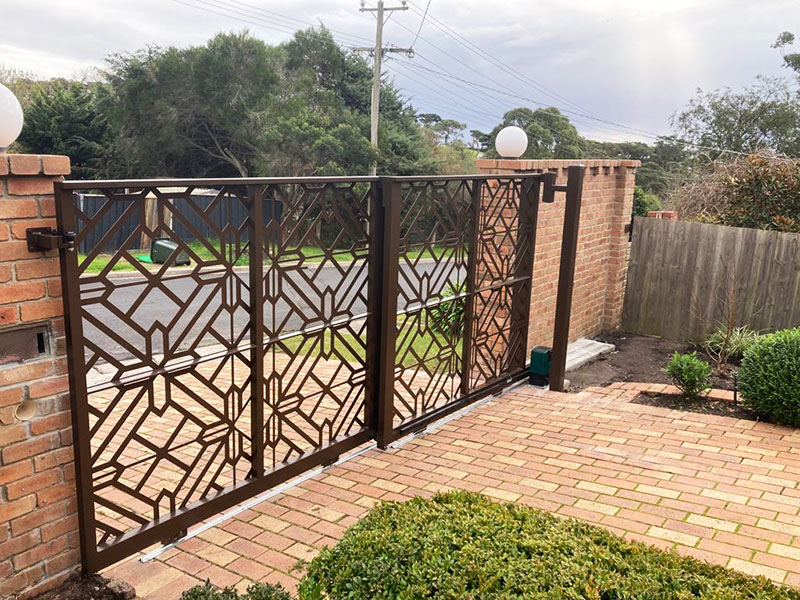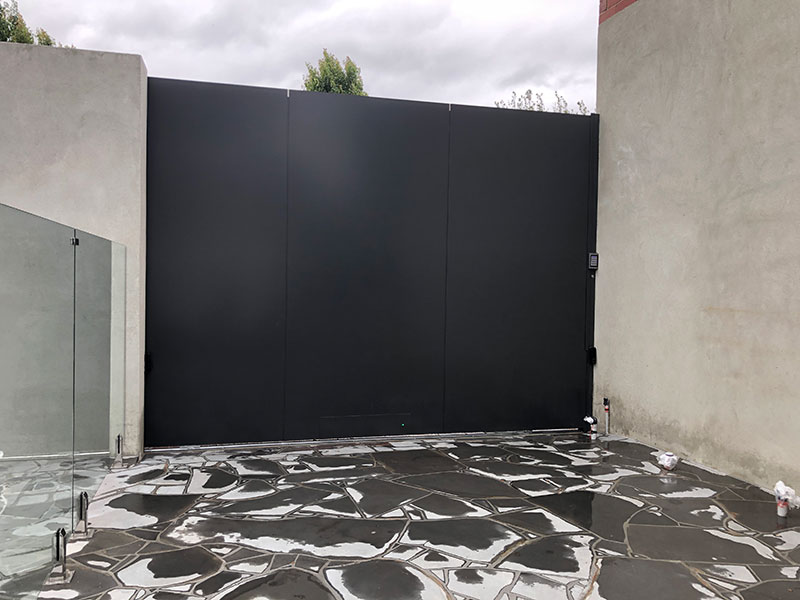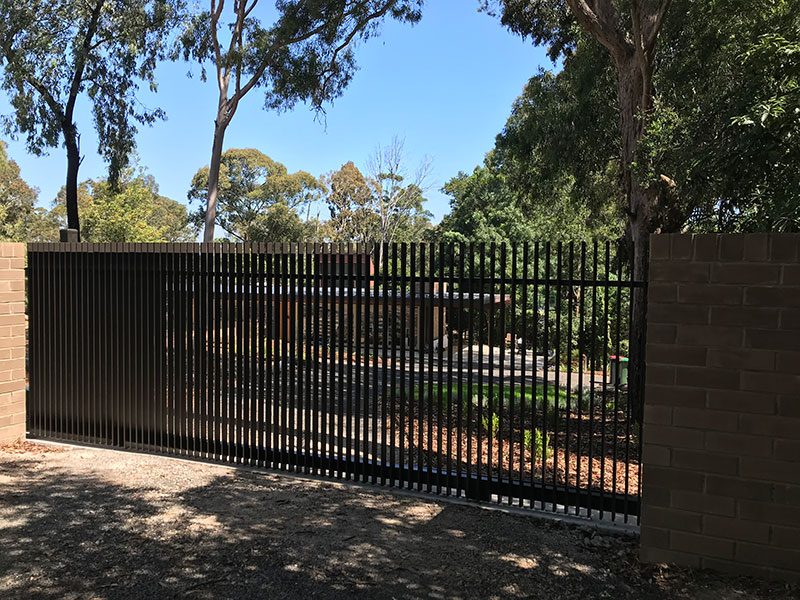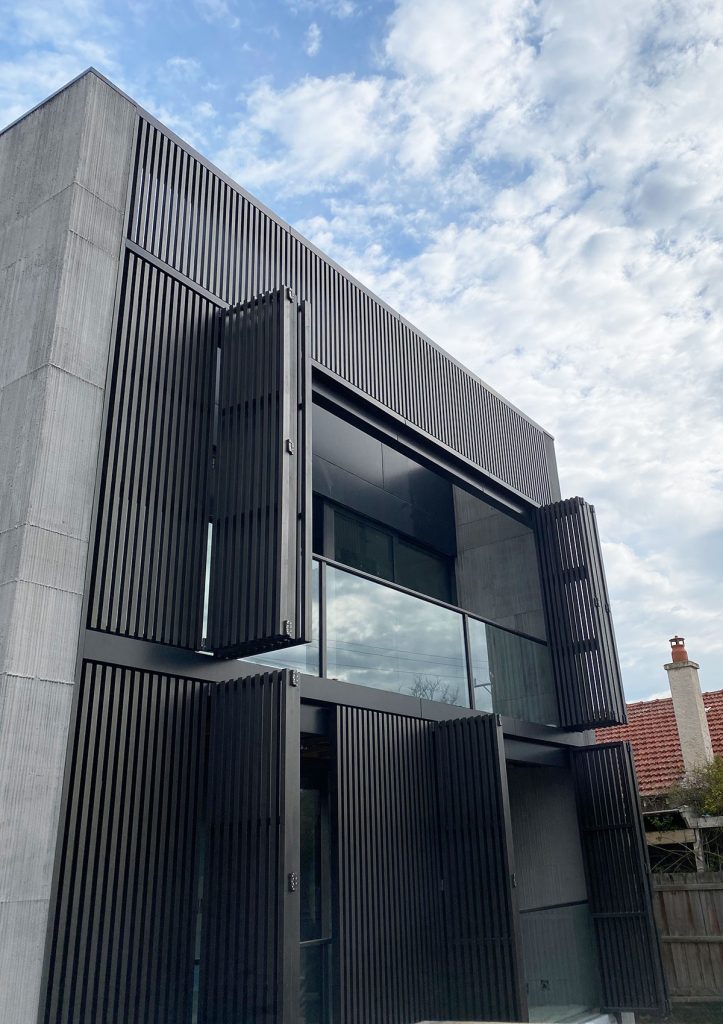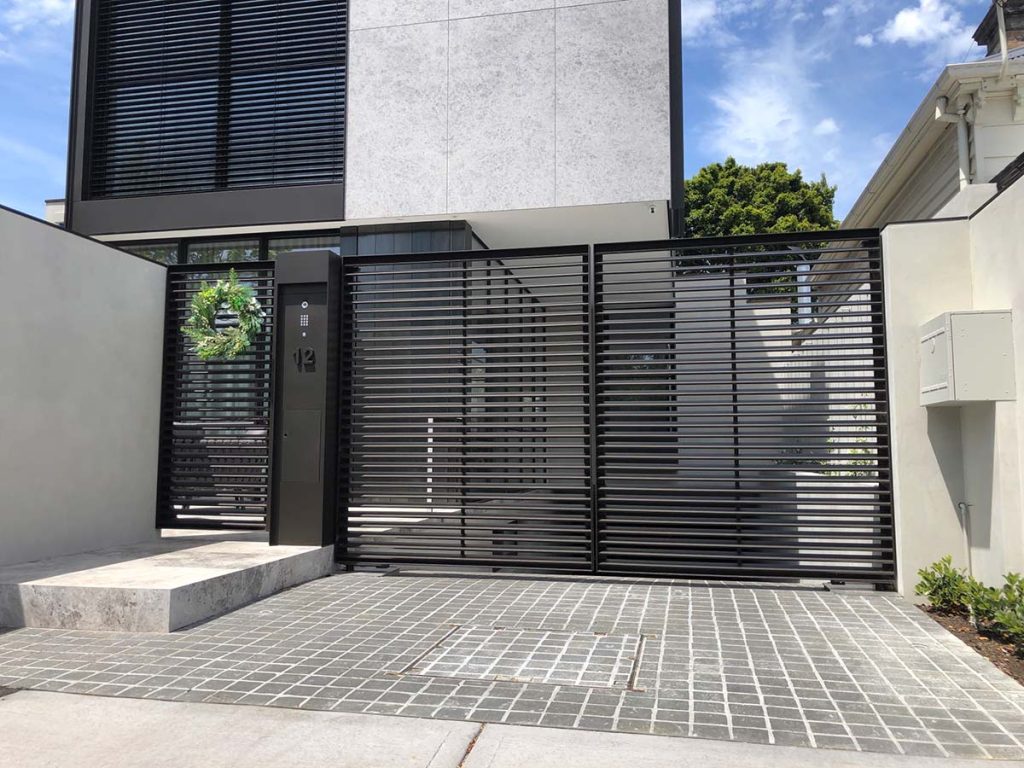
Residential Gate Opening Options
Automatic gates may require different opening systems like swing gates, sliding gates, cantilever gates, etc. based on various factors such as the size and shape of the opening, the level of security needed, side room, driveway space, driveway material, potential wind loading and various other factors. Read up below on what may suit your particular application best.
Sliding Floor Track
View Related GallerySliding floor track gates operate with wheels that slide on a linear floor track. They are super reliable. The motors can be set to operate the gate at high speeds, little force is transferred from the gate itself to the support/catch posts. The majority of the load is transferred through the wheels to the ground, so less issues with guide posts moving over time. The setup is quite simple, 2 wheels for the gate, a guide system and end stops. When closed, they are very secure. If there is room for the gate to retract (minimum gate opening + 200mm), this is probably the most popular and economical all round choice.
Pros :
- Cost effective
- Secure
- Simple to install and service
- Minimal force on guide system and support posts
- Minimal wind loading on motor
- Good choice for large gates
- Good choice for high wind areas
- Low maintenance
- Sliding gates can operate with fast motors
Cons :
- Floor track required across the driveway
- Concrete footing required (cannot mount directly to certain pavers, bitumen etc..)
- Space required for gate to retract
- Not ideal on bumpy ground
- Small amount of ground movement will affect rack and pinion alignment (chain systems can be used to overcome this)
Swing
View Related GallerySwing gates are very reliable option when the span is not too big, and wind loading is not a concern (high wind areas / cladding that catches the wind). As gates get larger and the cladding becomes a wind sail - sliding is the preferred method. Solid posts are required. The gates use hinges to swing open/closed. The setup is simple, solid posts/pillars and hinges. We always recommend a centre stop when possible, to increase the rigidity of the gates when closed, and minimize 'rocking' which over time transfers force back to the motor brackets and hinges, causing wear and tear. For larger gates we recommend the use of electric locks to help keep the gates secure and rigid.
Pros :
- Cost effective
- Relatively secure (very secure with the use of an electric lock)
- No need for retraction space either side of the gates
- If pillars are already in place – no need to install anything other than the gates and hinges
- Ground movement will affect alignment (via posts) though more tolerance than sliding
- No footing required across driveway
- Low maintenance (must keep hinges lubricated)
Cons :
- Solid posts are required
- High wind areas – Not the ideal choice as they get bigger, and cladding catches the wind
- The bigger the gate, the slower the motor will be setup to ensure smooth operation
- Cable is required for double gates on the far side
- Centre stop (when used) mounted in the driveway
- Custom hinges required if driveway slopes up (see rising hinges)
Sliding Cantilever
View Related GalleryThis is the most reliable, low maintenance, high security option available. Gates can not be lifted, ground movement across the driveway will not affect rack/pinion alignment, the gate can’t de-rail, no need to worry about floor track being damaged or debris build up, which all equates to low maintenance. The ideal sliding choice when you have the room to retract (needs approx. gate opening * 1.3 to retract fully). Ideal choice when you want sliding, though don’t want to install a footing across the driveway (Driveways that consist of bitumen, crushed rock etc..). Because there is nothing across the driveway, ideal for high traffic areas (heavy trucks, forklifts etc..). Not uncommon in commercial / industrial environments for floor track to be damaged.
Pros :
- Low maintenance
- No floor track across the driveway
- Sliding gates can operate with fast motors
- Cannot de-rail
- Secure – Very. Most secure gate available
- Generally minimal issues with ground movement
- Minimal force on guide system and support posts
- Minimal wind loading on motor
- Good choice for large gates
- Good choice for high wind areas
Cons :
- More space required to retract than a standard sliding gate
- Cost – More material (more heavy-duty frame), concrete works and Cantilever gate hardware
- Aesthetics – There is a cantilever channel welded to the bottom of each gate and a larger than normal bottom frame member to keep the gate rigid
- Large concrete footing needs to be installed to mount the cantilever trolleys and counterbalance the gate (though similar cost to a full-length concrete strip of a standard sliding gate)
- Larger gate = more difficult to install and transport
Dual Sliding
View Related GalleryDual sliding is when you have 2 sliding gates covering an entrance, with their own motor, and one opens left, the other right. The motors are usually linked so they operate together (called a master/slave setup). Dual sliding is a good option in 2 situations. If the gate opening is so large, it is easier and more economical to make and install 2 smaller gates. Also, if there is not enough space for a single sliding gate to retract one way. Dual sliding is a simpler setup than telescopic, with less moving parts. If the conditions of the site give a choice between telescopic and dual sliding, dual sliding would be our choice due to cost and simplicity.
Pros :
- Cost effective – especially in a situation where the opening is large. Can be cheaper that standard sliding on sites with a large opening
- Relatively secure. Though not as secure as single sliding or cantilever
- Simple to install and service
- Minimal force on guide system and support posts
- Minimal wind loading on motor
- Good choice for large gates
- Good choice for high wind areas
- Low maintenance
- Sliding gates can operate with fast motors – Double the speed with 2 gates
Cons :
- Floor track required across the driveway
- Concrete footing required (cannot mount directly to certain pavers, bitumen etc..)
- Space required for gate to retract on both sides
- Not ideal on bumpy ground
- Small amount of ground movement will affect rack and pinion alignment (chain systems can be used to overcome this)
- 2 motors are required. More cost and more technical
Telescopic
View Related GalleryA telescopic gate is a sliding gate that is made up with 2+ panels, with all panels operating off the one motor and retracting to one side in a ‘concertina’ fashion. This is achieved with a cable and pulley system. The second gate will travel at double the speed of the first gate. In 3 panel gates, the third gate will travel at double the speed of the second gate. You need a motor with good speed control/adjustment. Very handy in situations where you do not have enough side room for a standard sliding gate.
Pros :
- Relatively secure. Though not as secure as single sliding or cantilever
- Minimal force on guide system and support posts
- Minimal wind loading on motor
- Good choice for large gates. Though not as rigid as standard sliding
- Can open into spaces much smaller than the opening (depends on number of panels)
- Fast operation
Cons :
- Floor track required across the driveway. 2 rows for standard double telescopic / 3 rows for triple telescopic
- Cost – more expensive than standard or dual sliding. Even more so with triple telescopic
- Maintenance – telescopic system needs to be maintained
- Concrete footing required across the driveway
- Space required for gate to retract (although less than standard sliding)
- Not ideal on bumpy ground
- Ground movement will affect rack and pinion alignment
Sectional Sliding
View Related GallerySectional sliding is a sliding gate, usually made up of multiple panels linked with rotating hinges and wheels, all on the one track, that have the ability to operate in a nonlinear approach (bend around corners/objects). There is a single motor, and all the panels retract the same way. A very good option when there is minimal side room for a standard sliding gate, or even not enough room for telescopic – much less side room required.
Pros :
- Relatively secure. Though not as secure as single sliding or cantilever
- Minimal force on guide system and support posts
- Minimal wind loading on motor
- Can open into spaces much smaller than the opening (depends on number and size of panels. Less space required than any other sliding option)
- Can operate in many different configurations. Typical is for the gate to return into the property 90 degrees, though they can take on all sorts of different shapes to suit the particular application. Gate in the closed position can cover multiple angles, and then retract via multiple angles.
Cons :
- Floor track/footing required across the driveway, and returning in to the property
- Floor track must be accurately installed. Can not be done on bumpy ground
- Cost – most expensive sliding gate option
- Space required for gate to retract (although less than all other sliding options)
- Ground movement will affect rack and pinion alignment
- Technical – A lot of extra fabrication, hardware and installation time
Rising Hinge
View Related GalleryRising hinge gates are used when the gate needs to open up-hill. By offsetting the bottom hinge from the top hinge, the gate will lift as it opens. All our rising hinges are custom made inhouse to suit your particular gate and slope.
Pros :
- relatively secure (very secure with the use of an electric lock)
- No need for retraction space either side of the gates
- If pillars are already in place – no need to install anything other than the gates and hinges
- Ground movement will affect alignment (via posts) though more tolerance than sliding
- No footing required across driveway
- Low maintenance (must keep hinges lubricated)
Cons :
- Cost. Hinges cost more to make, and more powerful motors are usually required
- Centre stop is a must with rising hinge gates for longevity
- Solid posts are required
- Wind – Not the ideal choice as they get bigger, and cladding catches the wind
- The bigger the gate, the slower the motor will be setup to ensure smooth operation
- Cable is required for double gates on the far side
- Gates kick out as they open up-hill. This reduces opening.
- Extra stress is put on the motors, hinges, and posts.
Bifold
View Related GalleryBifold gates are swing gates (single or double) that are hinged on the support post/pillar, and in the middle of each gate. A custom hardware setup allows the gate(s) to bifold as they open. Very handy if you have a tight space to park your car, this will reduce the amount of space the gates encroach when open.
Pros :
- Relatively secure (Not as secure as standard swing)
- No need for retraction space either side of the gates
- If pillars are already in place – no need to install anything other than the gates and hinges
- Ground movement will affect alignment (via posts) though more tolerance than sliding
- No footing required across driveway
- Maximise usable driveway space with bifold opening
Cons :
- Cost. Bifold system is expensive
- Centre stop is strongly recommended
- Solid posts are required
- Wind – Not the ideal choice as they get bigger, and cladding catches the wind
- The bigger the gate, the slower the motor will be setup to ensure smooth operation
- Cable is required for double gates on the far side
- Gates take up more driveway width when open.
- Extra stress is put on the motors, hinges and posts.
- Technical – Extra fabrication, hardware and installation time
- Aesthetics – Extra hinges and hinge gaps are visible from the front with this approach
Top Hung Sliding Door
View Related GalleryTop Hung Sliding Doors are essentially a sliding gate, though the guide track is above the door. No floor track is required. A great option when there is a ceiling above the door, and room for the door to retract. Popular choice for garages that have suitable side room.
Pros :
- Cost effective – Similar to sliding (slightly more expensive hardware)
- No floor track required
- Very secure – can not de-rail with top guide
- Relatively simple to install and service
- No Support posts required. Top track and bottom floor mounted guide roller
- Minimal wind loading on motor
- Good choice for large doors
- Good choice for high wind areas
- Low maintenance
- Sliding doors can operate with fast motors
Cons :
- Top track required above door entrance – Ceiling / beam required
- Space required for gate to retract
Pedestrian
View Related GalleryPedestrian gates are usually a small single swing gate (which is what the pros and cons are based on). Though anything that is deemed for pedestrian use is a pedestrian gate. We have done sliding, cantilever sliding, rising hinge – any of the above can be a pedestrian gate. Generally, they are locked with a combination of a mortise lock with an electric strike for electronic release. We are now doing more and more fully automatic pedestrian gates. The cost of locks, electric strikes and door closers adds up. Automatic gates have superior operation, much more reliable, smoother and quieter closing than door closers, making them a popular choice when the gates are near bedrooms.
Pros :
- Quiet operation – compared to noise created from door closers when the lock and strike latches
- We use motors with in-built clutch systems. Gate motor clutch will kick in with any resistance, which means the gate can not be damaged by force, be it accidental or deliberate. Also recommend safety sensors to avoid this situation.
- Reasonable cost of automation compared to lock/strike/closer combination – Power and accessories add to this
- Very secure with the use of an electric lock – magnetic recommended
- No need for retraction space either side of the gates
- If pillars are already in place – no need to install anything other than the gates and hinges
- Ground movement will affect alignment (via posts) though more tolerance than sliding
- No footing required across driveway
- Low maintenance (must keep hinges lubricated)
Cons :
- Solid posts are required
- Cost. Once you include safety sensors, electric lock, running power to the motor, it does add up.
- Custom hinges required if driveway slopes up (see rising hinges)


